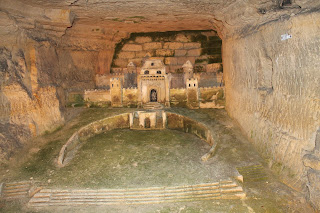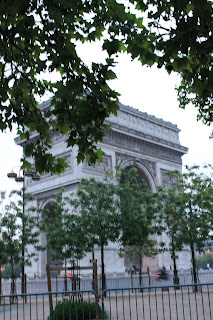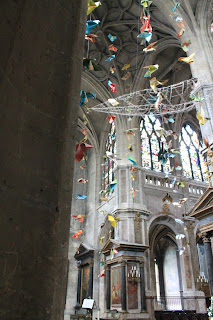Heute besuchen wir die Pariser Unterwelt, sie liegt ca 35m tief unter der Stadt, es herrschen ca 14°C und es ist ziemlich dunkel in den Katakomben von Paris, den Steinbrüchen aus denen die Stadt einst erwuchs, früher als Tagebau genutzt, ab dem 12 Jh. zunehmend unter Tage, entstand ein umfangreiches Stollennetz unter der Stadt. Manches, was einst in der Erde verborgen war, hat heute einen Platz an der Sonne, zum Beispiel die Steine, aus denen Notre Dame erbaut wurde. Irgendwann bestand der Untergrund von Paris aus mehr Hohlräumen, als aus Stein und dann machte sich die Gravitationskraft bemerkbar, ganze Straßenzüge brachen ein. Eilig wurden Ingenieure beauftragt, die Stabilität in der Stadt wieder herzustellen, anfangs mit mäßigem Erfolg, nach besserer Organisation und dem Entschluss, die Steinbrüche aufzugeben und die verbliebenen Hohlräume abzustützen bzw aufzufüllen, mit guten Resultaten.
Zeitgleich führte die Überbevölkerung der Stadt, und mit ihr alles, was das Leben im 17Jh für viele Menschen unattraktiv machte, wie Hunger, Seuchen, schlechte medizinische Versorgung und hohe Sterblichkeitsraten zu einer Überbelegung der städtischen Friedhöfe, die Liegezeiten wurden drastisch verkürzt und zeitweise wurden halbverweste Körper exhumiert, um Platz für frisch Verstorbene zu schaffen. Ach ja, die gute alte Zeit! Wohin nun aber mit den Gebeinen der teuren Toten? Eh, da war doch noch was, genau, die Katakomben! Zuerst wurde der „Cimetière des Innocents“ geräumt und die Gebeine über einen Schacht in die Tiefe versenkt, später wurden die Totengräber kreativer und schichteten die Knochen zu kunstvollen Bauwerken auf, zum Teil mit sehr dekorativen Ornamenten. Später folgten die Toten weiterer stillgelegter Friedhöfe aus der Innenstadt.
Heute werden die Katakomben zumeist für Versorgungsleitungen unter der Stadt genutzt, kann man nicht besichtigen, einen Teil beansprucht die Bank von Frankreich für die Goldreserven, kann man gar nicht besuchen, in manchen Stollen wurde in die Pariser Metro eingebaut, kann man erfahren und ein Teil ist für Touristen erschlossen.
Hier sieht man die "tags", die die Ingenieure hinterlassen haben, um zu sagen "ich war hier", oder ein Modell der Festung Port Mahon, die der Steinbrucharbeiter Décure, einstmals Soldat unter LouisXV., erschaffen hat, eine Reminiszenz an seine Zeit als Kriegsgefangener der Engländer.
Und die Gebeine von ca 6 Millionen Parisern, aufwendig drapiert in den Hallen, mit Kreuzen, die den Herkunftsort benennen und Sinnsprüchen rund das Sterben und den Tod.
Nach ca 1 Stunde gelangen wir über 83 Stufen wieder nach oben, durchlaufen eine Taschenkontrolle und nein, wir haben keine Knochen entwendet, wir haben unsere eigenen. Nun auf ins globale Kaffeegeschäft, wir wollen frühstücken.
Today we go and see the Paris Underworld, it´s about 35 m below the city, it´s 14°C (57F) and its´a bit dark here at the catacombs of Paris, in the quarries from those the city once arose, in the early days as a surface mining used, from the 12th cent. below ground, emerged a giant net of tunnels underneath the town. Many, what was hidden in the ground got it´s place at the sun up to now, for example the stones, the cathedral Notre Dame is made of. Somewhen the underground of Paris was made mostly of holes instead of stones, and the gravitation worked and some streets collapsed. Urgently some engineers were told, to rebuild the stability of town again, in the beginning not that successful, after better organisation of the system and the giving up of quarries, it worked well.
At the same time the over population of the city and with that, all those things, wich made life for people in the 17th cent. so unattractiv, like hunger, epidemics, bad medical conditiones and high mortality rate made, that the urban cemeteries where over crowded, the times the bodies remain there become shorter, sometimes half decayed bodied were exhumed to make way for the new deads. Oh, yes, the good ol' times!
But where do we put the bones of the beloved dead? Hey, there is something, isn´t it. Yupp, put it into the catacombs! At first the „Cimetière des Innocents“was closed and the bones where dumped down into over a shaft, later the gravedigger became more creative and arranged the bones and skulls in an very artifical way, with a lot of decorations. A time later the first bones were followed by the dead from other urban graveyards.
Today the most of the catacombs is used for pipes for water and electricity, one can´t see them, a part is used by the French Bank for the gold treassure, one can´t see them at all, a part was used for the Paris Metro, you can ride there and a part is to be seen by tourists:
There are tags to be seen, made by the engineers, to say "I worked here" or a modell of Port Mahon, made by a former stoneworker Décure, who was even soldier in King Louis XV. army, he made the place where he was imprisoned as a war prisoner by the English.
And there are the bones of 6 million Parisians, elaborat draped in the halls, with crosses telling were the bones come from and epigrams about dying and death.
After an hour we climbed up 83 steps, passed the bag check, we didn´t took any bones, we have ours, now lets go and see a global coffeeshop, it´s time for breakfast
Montag, 28. Mai 2012
Freitag, 25. Mai 2012
Abends in Paris - an evening in Paris
Saba ist zum Konzert von Sexion d'Assaut ( http://de.wikipedia.org/wiki/Sexion_d%E2%80%99Assaut ) und ich gehe mal nachsehen, ob alles noch so aussieht, wie immer. Also, ab in die Metro von Paris, die viertälteste in Europa, eingeweiht zur Weltausstellung 1900, mit dem wahrscheinlich geringsten Abstand zwischen den Stationen (im Durchschnitt 500m), welche ich am Palais der Weltausstellung von 1900 am Champs Elysees verlasse. Ohne künstliche Beleuchtung, es ist ca 21 Uhr und somit noch hell, sieht der Boulevard nicht ganz so eindrucksvoll aus, wie im Dunklen. Mein Ziel ist der Arc de Triomphe, von dort habe ich einen Blick bis nach La Défence. Und dann biege ich nach links ab, schlage mich durch viele kleine Seitenstraßen und verpasse den Trocadero und stehe dann vor dem Eiffelturm (sieht übrigens aus, wie der Tokyo Tower, haha Mörderjoke), weiche geschickt den freundlichen jungen Männern aus, die mit just jenen Turm, als Modell natürlich, für einen Euro verkaufen wollen und laufe weiter unter der illuminierten Stahlkonstruktion hindurch, die Av. Gustave Eiffel entlang und von dort zurück zur Seine. Hier gibt es ein sehr bizarres Haus, dessen Fassade nicht verputzt ist, sondern "verpflanzt". Zurück über die Pont Alma, vorbei an einer Replik der Flamme der Freiheitsstatue von New York, welche den Pariser von den New Yokern geschenkt wurde, nachdem jene diesen die Freiheitsstatue schenkten. Alles klar? Gut! Auch gibt es hier immer ein paar Blumen von Hardcorefans, den hier starb Lady Di vor ewiger Zeit. Zurück in die Metro, Fazit, ja, alles so wie immer. Morgen mehr.
Saba is at the concert of Sexion d'Assaut ( http://de.wikipedia.org/wiki/Sexion_d%E2%80%99Assaut ) and I go out checking, if everything is still like it was before. So, down into the Paris Metro, one of the four eldest in Europa, opened during the World Exibition 1900, with the probably shortest distance between two stations ( about 500m ), wich I do leave at the Grande Palaise of the World Exibition at the Av. des Champs Elyseees. Without artificial light it´s not that impressiv, but it´s 9pm, and that´s why still light. I´m going to see the Arc de Triomphe and from there I can see La Défence afar. Now turning left, bluff my way through a lot of small sideways, miss the Trocadero and standing in front of the Eiffel Tower ( looks absolutely like the Tokyo Tower, haha murderjoke), go skilful out of the way of the young men, who would like to sell the tower to me, as a model of course, for only one Euro and going my way under the illuminated construction of steel, than through the Av. Gustave Eiffel and back to the Seine , where there is very bizarre house, wich is not plastered, but "planted". Going over the bridge Pont Alma, across a replica of the flame of the Statue of Liberty, wich the New Yorkers gave to the Parisians, after been given the Statue of Liberty from them. Everyone get this? Cool. There are also alltime flowers here, brought by hardcore fans,because it´s the place where Lady Di died ages ago. Back into the Metro, conclusion, yes, everything is still like it was. Tomorrow more.
Saba is at the concert of Sexion d'Assaut ( http://de.wikipedia.org/wiki/Sexion_d%E2%80%99Assaut ) and I go out checking, if everything is still like it was before. So, down into the Paris Metro, one of the four eldest in Europa, opened during the World Exibition 1900, with the probably shortest distance between two stations ( about 500m ), wich I do leave at the Grande Palaise of the World Exibition at the Av. des Champs Elyseees. Without artificial light it´s not that impressiv, but it´s 9pm, and that´s why still light. I´m going to see the Arc de Triomphe and from there I can see La Défence afar. Now turning left, bluff my way through a lot of small sideways, miss the Trocadero and standing in front of the Eiffel Tower ( looks absolutely like the Tokyo Tower, haha murderjoke), go skilful out of the way of the young men, who would like to sell the tower to me, as a model of course, for only one Euro and going my way under the illuminated construction of steel, than through the Av. Gustave Eiffel and back to the Seine , where there is very bizarre house, wich is not plastered, but "planted". Going over the bridge Pont Alma, across a replica of the flame of the Statue of Liberty, wich the New Yorkers gave to the Parisians, after been given the Statue of Liberty from them. Everyone get this? Cool. There are also alltime flowers here, brought by hardcore fans,because it´s the place where Lady Di died ages ago. Back into the Metro, conclusion, yes, everything is still like it was. Tomorrow more.
Neben der großen Kirche - Beside the big church
Während ich in Notre Dame über Quasimodo und Esmeralda meditierte, erkundete Saba (http://www.theurbanmaiden.com/) das Umfeld und zeigte mir dann die Ergebnisse ihrer Erkundungstour, die sie am Hotel de Ville, dem Rathaus von Paris, vorbei zum Centre Pompidou und an die Peripherie von Les Halles geführt hatte.
Die Brunnen am Centre Pompidou warteten noch auf ihren finalen Neuanstrich und waren darum noch nicht mit Wasser gießen und spritzen und werfen beschäftigt. Schade! Na, beim nächsten Mal.
Wir genossen nun einen globalen Kaffee im Caféhaus meiner Wahl und machten uns auf die Suche nach der Rue St. Martin.
Dort entdeckte Saba zufällig St. Merry, eine der unprätentiösesten Kirchen, die ich bislang besucht habe. Erbaut im 16.Jh, im spätgotischen Stil, beherrbergt sie die älteste Glocke von Paris (1331), die Academie Vocale de Paris, die jeden Samstag Konzerte gibt und die schönste Innenraumdeko.
Noch einen kurzen Abstecher in der kleinen Park rund um den Tour St. Jacques, einzig erhaltener Rest einer spätgotischen Kirche, die der Pariser Fleischerinnung als Gebetsstätte diente. Dort steht Blaise Pascal, als Statue, zum Erinnern daran, dass er auf der Spitze des 52m hohen Turms den Luftdruck messen wollte.
Nun ist der Kirchentag für heute beendet, wir machen Pause.
While I was meditating in Notre Dame about Quasimodo and Esmeralda, Saba (http://www.theurbanmaiden.com/) was checking the outer area of the cathedral and showed me later the results of her research, wich leaded her at first to the Hotel de Ville, the townhall of Paris, along the Centre Pompidou towards the circuit of Les Halles.
The wills at Centre Pompidou are waiting for their final finish of new color and that´s why no water sprinkling, waving, pouring. Pity! But next time.
We enjoyed a global coffee in my favorit coffeeshop und than we were looking for Rue St. Martin. By coincidence Saba dicovered there one of the less pretentious churches I´ve ever seen . St. Merry, build in 16th cent. in late gothic style, houses the eldest bell in Paris (1331), the Academie Vocale de Paris, wich is helding concerts every saturday and the most beautiful inside decoration ever.
Now a short turn to the little park, wich is surrounding the Tower St. Jacques, the only leftover of a late gothic church, where the guild of butchers went to mess in former time. There we saw Blaise Pascal, we saw a sculpture of cource, as a memorial that he tried to meassure the air pressure at the top of the 52m high tower.
Now church congress is done for today, we are off for a break.
Die Brunnen am Centre Pompidou warteten noch auf ihren finalen Neuanstrich und waren darum noch nicht mit Wasser gießen und spritzen und werfen beschäftigt. Schade! Na, beim nächsten Mal.
Wir genossen nun einen globalen Kaffee im Caféhaus meiner Wahl und machten uns auf die Suche nach der Rue St. Martin.
Dort entdeckte Saba zufällig St. Merry, eine der unprätentiösesten Kirchen, die ich bislang besucht habe. Erbaut im 16.Jh, im spätgotischen Stil, beherrbergt sie die älteste Glocke von Paris (1331), die Academie Vocale de Paris, die jeden Samstag Konzerte gibt und die schönste Innenraumdeko.
Noch einen kurzen Abstecher in der kleinen Park rund um den Tour St. Jacques, einzig erhaltener Rest einer spätgotischen Kirche, die der Pariser Fleischerinnung als Gebetsstätte diente. Dort steht Blaise Pascal, als Statue, zum Erinnern daran, dass er auf der Spitze des 52m hohen Turms den Luftdruck messen wollte.
Nun ist der Kirchentag für heute beendet, wir machen Pause.
While I was meditating in Notre Dame about Quasimodo and Esmeralda, Saba (http://www.theurbanmaiden.com/) was checking the outer area of the cathedral and showed me later the results of her research, wich leaded her at first to the Hotel de Ville, the townhall of Paris, along the Centre Pompidou towards the circuit of Les Halles.
The wills at Centre Pompidou are waiting for their final finish of new color and that´s why no water sprinkling, waving, pouring. Pity! But next time.
We enjoyed a global coffee in my favorit coffeeshop und than we were looking for Rue St. Martin. By coincidence Saba dicovered there one of the less pretentious churches I´ve ever seen . St. Merry, build in 16th cent. in late gothic style, houses the eldest bell in Paris (1331), the Academie Vocale de Paris, wich is helding concerts every saturday and the most beautiful inside decoration ever.
Now a short turn to the little park, wich is surrounding the Tower St. Jacques, the only leftover of a late gothic church, where the guild of butchers went to mess in former time. There we saw Blaise Pascal, we saw a sculpture of cource, as a memorial that he tried to meassure the air pressure at the top of the 52m high tower.
Now church congress is done for today, we are off for a break.
Abonnieren
Kommentare (Atom)


























































